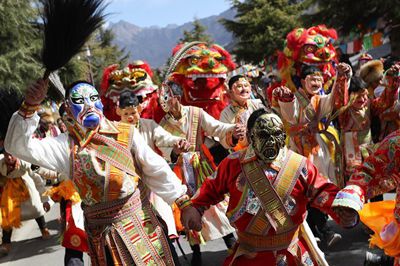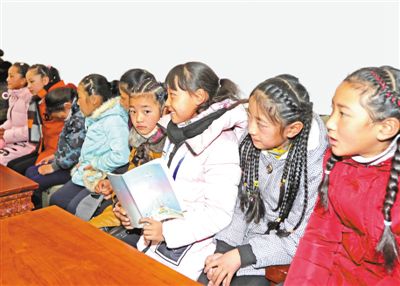|
The 1959 democratic reform abolished feudal serfdom, and made fundamental reforms in the ownership of the means of production, which prompted rapid economic development. As demanded by the serfs, who accounted for the overwhelming majority of Tibet's population, 95 percent or more of the land, livestock and other major means of production in Tibet that had been owned by the feudal upper class [2] (five percent of the population) were distributed among serfs; the private economy ownership of farmers and herdsmen was set up; and policies in favor of stable development were carried out. The reform of the ownership of the means of production greatly liberated the productive forces, and therefore Tibet saw unprecedented rapid growth in its economy. Some documents indicate that in the decade prior to the democratic reform in 1959, Tibet's economic aggregate was around 150 million yuan, showing that its economy was almost stagnant. In the six years from the 1959 democratic reform to 1965, when the Tibet Autonomous Region was established, Tibet's economic aggregate rocketed to 327 million yuan, with an annual growth rate of 11.1 percent. Tibet's economy entered a stage of rapid development.
-- 1965-1984: From the formal establishment of the People's Government of the Tibet Autonomous Region to the adoption of the reform and opening-up policy in 1978
After the People's Government of the Tibet Autonomous Region was formally established in 1965, the central government adopted policies one after another to give economic support to Tibet to guarantee its stable economic development. In 1984, when the inland areas saw initial achievements in reform and opening-up, the central authorities held the Second Tibet Work Symposium in Beijing. The meeting decided to continue the special preferential policy for rehabilitation in Tibet's rural areas: In farming areas "land should be used by individual farm households for their own production, a policy which would be kept unchanged for a long time to come"; in pastoral areas "livestock should be owned and raised by individual herder households, a policy which would be kept unchanged for a long time to come." In the same year, Tibet's government declared that it would carry out the policy of opening to inland China and to foreign countries. For this, 1984 is usually regarded as a key year in Tibet's opening-up. [3] We have noticed that in most of this period Tibet's economy experienced relatively stable growth, with an annual growth rate of 7.82 percent, although the growth rate was slower than that in the previous stage because Tibet's reform and opening-up was nearly six years later than inland China's, and it underwent the negative influence of the "cultural revolution" (1966-1976) at the start.
-- 1984-present: From the adoption of the reform and opening-up policy to the present
Since Tibet launched reform and opening-up in 1984, the strategy of opening-up and the basic role of the market have provided strong support for Tibet's economic development. In the meantime, the central government's policies and financial support, coordinated assistance from more developed inland provinces and cities and the joint efforts of the people of all the ethnic groups in Tibet combined to lift Tibet to a stage of the fastest economic growth in its history. The economic aggregate soared from1.368 billion yuan in 1984 to 39.591 billion yuan in 2008, an increase of 11.3 times within 25 years calculated by comparable price, and the annual growth rate reached a high level of 10.5 percent. To promote better and faster economic development in Tibet, the central government held the Fourth Tibet Work Symposium in 2001. The meeting decided upon 117 state-invested projects, involving a total of 31.2 billion yuan; moreover, the central government provided 38 billion yuan in financial subsidies, while 70 coordinated assistance projects and Tibet-aid funds from around the country involved over three billion yuan. Driven by such a huge investment, the economic aggregate of Tibet rose from 13.916 billion yuan in 2001 to 39.591 billion yuan in 2008, with a high annual growth rate of 12.4 percent. In 2006, the per capita GDP of Tibet exceeded 10,000 yuan, a milestone marking that Tibet was no longer in the last place in China economically. [4] |
- Home
- News |Tibet |Exclusive |China |World |Other Tibetan-Inhabited Area |Tibet through the Eyes of Foreigners |Related News
- Documents |White Papers |Others
- Photo |Politics |Economy & Society |Culture & Religion |Human & Nature |Beautiful Tibet |Other Tibetan-Inhabited Area |Exchanges |Related
- Video |News |Documentary |Micro-Video |Entertainment
- Art
- Tourism
- In Focus
- About Tibet






